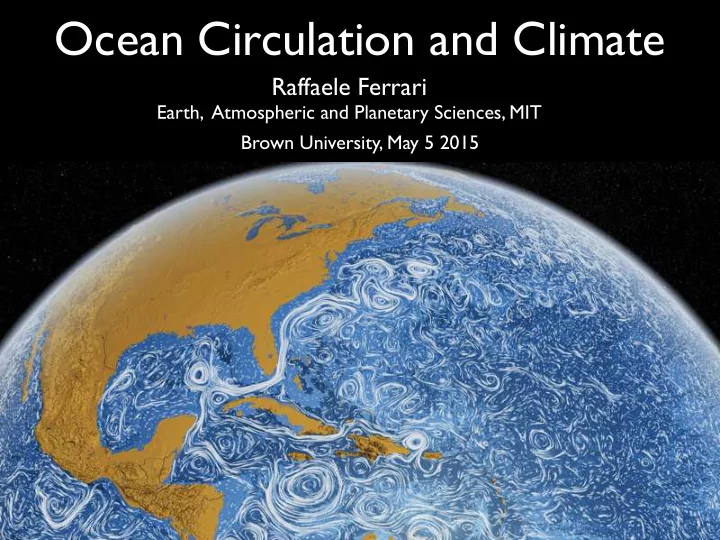

Ocean Circulation and Climate Raffaele Ferrari Earth, Atmospheric and Planetary Sciences, MIT Brown University, May 5 2015
Deep Ocean and Climate
Ocean and Climate Ocean Heat Uptake Ocean Carbon Uptake IPCC, 2015, third chapter IPCC, 2015, sixth chapter
Ocean Heat Uptake Pathways of ocean heat uptake Observed temperature trends Durack and Wijffels (2010) IPCC, 2015, third chapter
Ocean Carbon Uptake Observed anthropogenic carbon inventory IPCC, 2015, sixth chapter
Southern Ocean
A Theory of the Abyss Zonally averaged neutral density from WOCE climatology 0 22 23 24 Neutral density [kg/m 3 ] 25 − 1000 26 27 Depth [m] 27.2 − 2000 27.4 27.6 27.8 28 − 3000 28.1 28.2 28.3 − 4000 28.4 − 80 − 60 − 40 − 20 0 20 40 60 80 Latitude Zonally averaged circulation from Lumpkin and Speer (2007)
Southern Ocean Ocean sea surface height (Jason and GRACE satellite missions)
Southern Ocean Dynamics Idealized model of Southern Ocean circulation (Abernathey et al., 2011) Ocean Basins Antarctica Movie generated by Ryan Abernathey
Southern Ocean Dynamics • Nonlinear momentum budget of the Southern Ocean ψ = wind macroturbulence − wind stress = K × density slope − 2 × days × sin(latitude) = τ Ks − | f | Marshall and Speer (2012)
Future Climate
Changes in Roaring Forties • Positive trend in Southern Annular Mode over last 30 years • Strength of Southern Hemisphere westerlies has increased Swart and Fyfe (2012)
Changes in Roaring Forties • Le Quéré et al. (2007) speculated that increase in wind strength would - strengthen upper cell and increase ocean release of deep carbon ψ upper = τ | f | − Ks > 0 - weaken lower cell and slightly decrease ocean release of abyssal carbon ψ lower = τ | f | − Ks < 0
Eddy compensation • Increase in winds is accompanied by an increase in macro turbulence • Increase in macro turbulence results in an increase in eddy diffusivity ψ wind = τ | f | ψ upper = τ | f | − Ks > 0 ψ lower = τ | f | − Ks < 0 Abernathey et al. et al. (2012)
Ocean macro turbulence • Need theories of nonlinear turbulent equilibration of Southern Ocean K = K ( τ , f, topography , bottom friction , ... ) Theory for interaction of macro DIMES Experiment turbulence with mean circulation MIT General Circulation Model
Eddy-mean flow interactions • Strong jets reduce mixing by macro turbulence across jets ⌘ 3 / 2 ⇣ | u 0 | 2 K ' ` eddy u 2 8¯ Diffusivity K 150 o W 145 o W 140 o W 135 o W 130 o W 125 o W 150 o W 145 o W 140 o W 135 o W 130 o W 125 o W − 1.2 0 0.8 32 o S 32 o S − 30 Mean flow Eddy flow Eddy Full Theory − 35 40 o S − 40 40 o S − 45 Latitude − 50 48 o S 48 o S − 55 − 60 − 65 56 o S 0 500 1000 1500 2000 2500 3000 3500 4000 4500 56 o S 2 s − 1 ) Effective diffusivity, (m — ``Observed’’ K — No eddy mean interactions - - With eddy mean interactions − 0.2 0 0.2 64 o S 64 o S Ferrari & Nikurashin (2010)
Macro turbulence models • Quasi-Geostrophic dynamics ∂ t q + J ( ψ , q ) = 0 ✓ f 2 ◆ q = f + r 2 ψ + ∂ ∂ψ N 2 ∂ z ∂ z • Quasi-Geostrophic stochastic models of ocean macro-turbulence q + J ( ¯ ∂ t ¯ ψ , ¯ q ) = � J ( ψ 0 , q 0 ) , ✓ f 2 ∂ ¯ ◆ ψ + ∂ ψ q = f + r 2 ¯ ¯ N 2 ∂ z ∂ z ∂ t q 0 + J ( ¯ ψ , q 0 ) + J ( ψ 0 , ¯ q ) = F ( x, y, z ) R ( t ) � λ q 0 ✓ f 2 ◆ q 0 = r 2 ψ 0 + ∂ ∂ψ 0 N 2 ∂ z ∂ z Ferrari and Nikurashin (2010); Fitzgerald et al. (2015)
Conclusions ‣ The deep ocean circulation and stratification is controlled by - winds and air-sea fluxes acting on the Southern Ocean - air-sea fluxes in the North Atlantic - macro turbulence in the Southern Ocean - micro turbulence in the Atlantic, Indian and Pacific Oceans Ferrari (Nature, 2014)
Recommend
More recommend